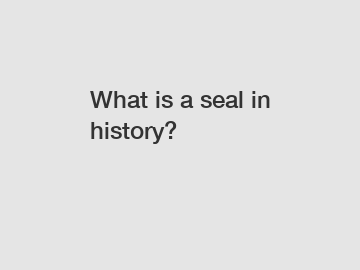What is a seal in history?
Seals have been an important part of human history for centuries. These small, often intricate objects hold a wealth of information about the past and provide valuable insights into the cultures and societies that created them. From ancient civilizations to medieval Europe, seals have played a crucial role in the communication and identification of individuals and institutions. In this blog post, we will explore the significance of seals in history and delve into their fascinating evolution over time.
Seals, also known as signets, are small objects typically made of stone, metal, or other materials, that are used to impress a design onto a soft material such as wax, clay, or paper. The design on the seal is often a unique symbol or image that represents the individual or organization it belongs to. Seals were used to authenticate documents, letters, and other important items, ensuring their authenticity and preventing tampering or forgery.
The use of seals dates back to ancient times, with some of the earliest examples found in Mesopotamia and ancient Egypt. These early seals were typically made of stone or clay and were inscribed with images or symbols that represented the individual or institution they belonged to. Seals were used to mark ownership of property, validate transactions, and secure important documents.

In ancient Greece and Rome, seals were used by officials, merchants, and individuals of high social status to authenticate legal documents and correspondence. These seals were often made of precious metals such as gold or silver and were highly ornate, featuring intricate designs and inscriptions. Seals were also used as a form of personal identification, with individuals carrying them on rings or cords around their necks.
During the medieval period in Europe, seals played a crucial role in the administration of government and the enforcement of law. Kings, nobles, and bishops used seals to validate decrees, charters, and other official documents. Seals were also used to mark the authenticity of coins and to secure containers and packages. The wax seals used during this period often bore the image of the owner, along with symbols of their power and authority.
One of the most famous uses of seals in history is the Great Seal of the United States. Designed in 1782, the Great Seal features the bald eagle clutching arrows and an olive branch, symbolizing the nation's strength and peace. The Great Seal is used on all official documents of the U.S. government, including currency, passports, and treaties. Seals continue to play a vital role in the modern world, with governments, corporations, and individuals using them to verify authenticity and protect valuable information.
Seals are not only functional but also hold significant artistic and cultural value. Throughout history, seals have been adorned with intricate designs and symbols that reflect the beliefs, values, and traditions of the societies that created them. Seals have been used to convey messages, express identity, and commemorate important events. The study of seals, known as sigillography, is an important field of research that provides valuable insights into the social, political, and economic history of past civilizations.
In conclusion, seals are a fascinating and important aspect of human history. From ancient civilizations to modern governments, seals have played a crucial role in communication, identification, and authentication. The evolution of seals over time reflects the changing needs and priorities of societies and provides a window into the beliefs and values of the past. Seals continue to be used today as a symbol of authority, authenticity, and tradition, connecting us to our shared history and heritage.
The company is the world’s best kingseal industry, O Ring Kit Boxes, oring kit box supplier. We are your one-stop shop for all needs. Our staff are highly-specialized and will help you find the product you need.

Comments
0